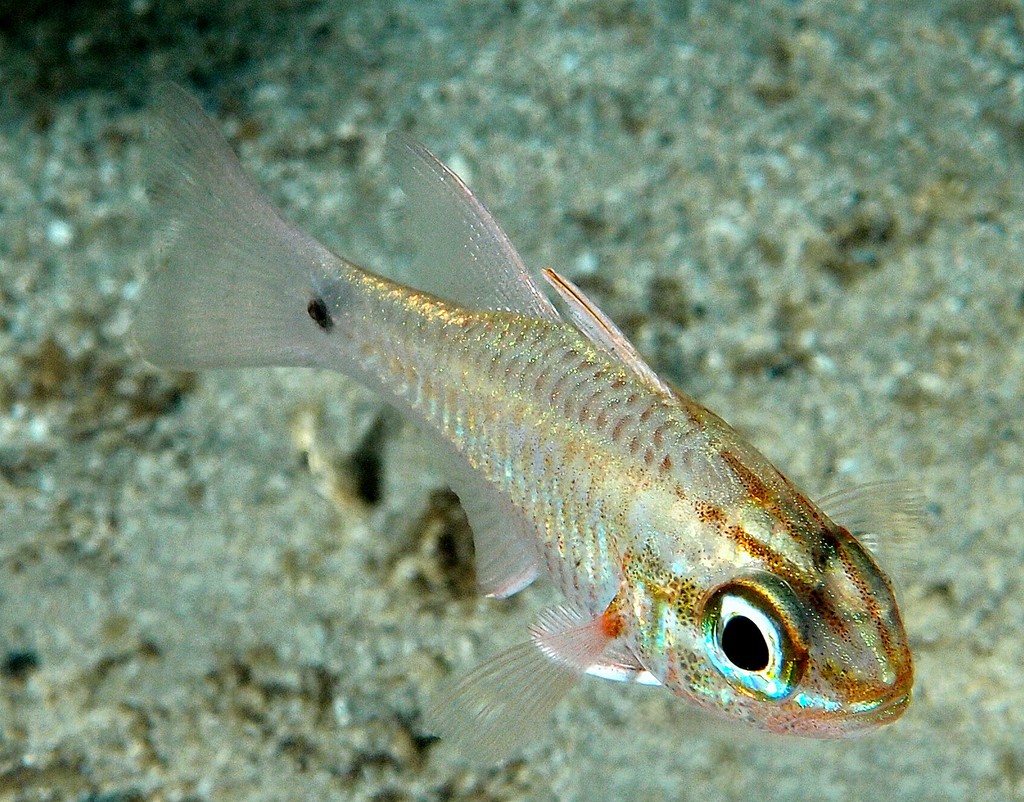OSTORHINCHUS NORFOLCENSIS - (OGIBLY, 1888)
Actinopterygii (Gigaclass) > Actinopteri (Class) > Teleostei (Subclass) > Gobiiformes (Order) > Apogonoidei (Suborder) > Apogonidae (Family) > Apogoninae (Subfamily) > Ostorhinchus (Genus)
Apogon de Norfolk, Poisson-cardinal de Norfolk, Norfolk cardinalfish, Norfolk-Kardinalbarsch, 諾福天竺鯛,
Synonyme
Apogon norfolcensis (Ogibly, 1888)
----------------------
Description
Dorsal spines (total): 7-8; Dorsal soft rays (total): 9-10; Anal spines: 2; Anal soft rays: 8-9; Pectoral fin rays: 14-15 (usually: 15); Pelvic fin rays: I, 5; Caudal fin rays: 17; Lateral line scale: 24. Snout obtuse and short. Occiput slightly concave; Jaws equal; The maxilla reaches to the vertical from the posterior fourth of the orbit. Teeth villiform in jaws, vomer, and palate. Max. length: 15.0 cm TL, commonly: 10.0 cm TL. Depth range: 1 m - 10 m.
Color
Dusky brown body with a prominent black spot on the tail base, two broad dusky bars on the body, a pale iridescent blue stripe from the snout through the lower part of the eye onto the gill cover and curving abruptly downwards, a narrow brown stripe above the eye, dark centres on the body scales along the back, and pale centres on the lower body scales.
Etymology
Ostorhinchus: from Greek, osteon = bone + from Greek, rhynchos = beak. In reference to the bony jaws, very much advanced and jagged, which take the place of the teeth.
norfolcensis: from type locality, Norfolk Island (between Australia, New Zealand and New Caledonia).
Original description: Apogon norfolcensis Ogilby, 1888 - Type locality: Norfolk Island.
Distribution
Southwestern Pacific: Lord Howe Island and Norfolk Island (Australia), southern New Caledonia.
Biology
Inhabits coral reef. Found inshore. Mouthbrooders. Distinct pairing during courtship and spawning.
Last update: 6, May 2024
Apogon de Norfolk, Poisson-cardinal de Norfolk, Norfolk cardinalfish, Norfolk-Kardinalbarsch, 諾福天竺鯛,
Synonyme
Apogon norfolcensis (Ogibly, 1888)
----------------------
Description
Dorsal spines (total): 7-8; Dorsal soft rays (total): 9-10; Anal spines: 2; Anal soft rays: 8-9; Pectoral fin rays: 14-15 (usually: 15); Pelvic fin rays: I, 5; Caudal fin rays: 17; Lateral line scale: 24. Snout obtuse and short. Occiput slightly concave; Jaws equal; The maxilla reaches to the vertical from the posterior fourth of the orbit. Teeth villiform in jaws, vomer, and palate. Max. length: 15.0 cm TL, commonly: 10.0 cm TL. Depth range: 1 m - 10 m.
Color
Dusky brown body with a prominent black spot on the tail base, two broad dusky bars on the body, a pale iridescent blue stripe from the snout through the lower part of the eye onto the gill cover and curving abruptly downwards, a narrow brown stripe above the eye, dark centres on the body scales along the back, and pale centres on the lower body scales.
Etymology
Ostorhinchus: from Greek, osteon = bone + from Greek, rhynchos = beak. In reference to the bony jaws, very much advanced and jagged, which take the place of the teeth.
norfolcensis: from type locality, Norfolk Island (between Australia, New Zealand and New Caledonia).
Original description: Apogon norfolcensis Ogilby, 1888 - Type locality: Norfolk Island.
Distribution
Southwestern Pacific: Lord Howe Island and Norfolk Island (Australia), southern New Caledonia.
Biology
Inhabits coral reef. Found inshore. Mouthbrooders. Distinct pairing during courtship and spawning.
Last update: 6, May 2024
